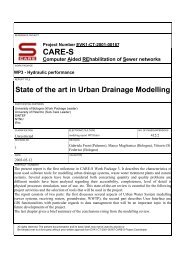Modeling
R184_CHI_Rules
R184_CHI_Rules
You also want an ePaper? Increase the reach of your titles
YUMPU automatically turns print PDFs into web optimized ePapers that Google loves.
Uncertainty Analysis 161<br />
area, New Jersey. (Water Science and Technology Vol 36 No 5 pp 141-<br />
148.(Anonymous, 1997).<br />
The American Water Works Association (AWWA) Engineering Computer<br />
Applications Committee indicate that true model calibration is achieved by<br />
adjusting whatever parameter values need adjusting until a reasonable<br />
agreement is achieved between model-predicted behavior and actual field<br />
behavior (AWWA Engineering Computer Applications Committee 1999). Once<br />
a model is considered to be calibrated, it can then be used, among other<br />
purposes, to estimate hydraulic characteristics of the real-world system at<br />
locations where measured data are unavailable or unknown, spatially and<br />
temporally.<br />
In the US, definitive standards to assess the accuracy of water distribution<br />
model calibration have yet to be agreed upon or established. However, the<br />
following calibration criteria have been suggested:<br />
1. An average pressure difference of ±2.2 psi with a maximum difference<br />
of ±7.3 psi for a good data set, and an average pressure difference of<br />
±4.3 psi with a maximum difference of ±14.2 psi for a poor data set<br />
(Walski 1983); and<br />
2. The difference between measured and simulated values should be ±5 psi<br />
to ±10 psi (Cesario and Davis 1984).<br />
According to the AWWA Engineering Computer Applications Committee<br />
(1999), ten sources of possible error could cause poor agreement between water<br />
distribution model values and measured field values. These sources of error,<br />
which provide a potential list of factors that can be adjusted during the modelcalibration<br />
process, are:<br />
1. errors in input data (measured and typographic),<br />
2. unknown pipe roughness values (i.e., Hazen-Williams C-factors),<br />
3. effects of system demands (distributing consumption along a pipe to a<br />
single node),<br />
4. errors in data derived from network maps,<br />
5. node elevation errors,<br />
6. errors introduced by time variance of parameter values such as storage<br />
tank water levels and pressures,<br />
7. errors introduced by a skeletal representation of the network as opposed<br />
to modeling all small-diameter pipes,<br />
8. errors introduced by geometric anomalies or partially closed valves,<br />
9. outdated or unknown pump-characteristic curves, and<br />
10. poorly calibrated measuring equipment including data loggers, tank<br />
water-level monitors, and SCADA systems.<br />
Model calibration entails adjusting model parameter values until an acceptable<br />
match is achieved between measured data and model-simulated values (e.g.<br />
pressures at the test hydrants, water levels in the storage tanks, flows from<br />
booster pumps, and pumpage from groundwater wells). The ten sources of<br />
possible error that could lead to model simulated values not agreeing with




